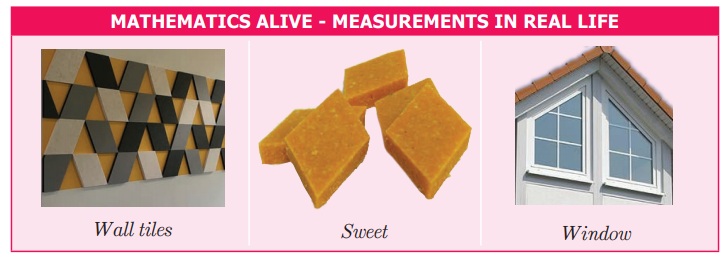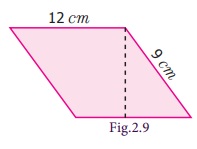Measurements | Term 1 Chapter 2 | 7th Maths - Area and Perimeter of the Parallelogram | 7th Maths : Term 1 Unit 2 : Measurements
Chapter: 7th Maths : Term 1 Unit 2 : Measurements
Area and Perimeter of the Parallelogram
Parallelogram
Ask any four students to come with a rope to
form a rectangle ABCD as shown in Fig 2.2(i). Students standing at C and D are
asked to move 4 equal steps to their left to form the shape as shown in Fig.
2.2(ii). Now, the new shape formed is called parallelogram.
The pair of sides AB and CD are parallel to each other and the other pair of
sides BC and AD are also parallel to each other. The length of the parallel
sides are found to be equal.

Hence, we can conclude that a parallelogram is
a four sided closed shape, in which opposite sides are both parallel and equal.
MATHEMATICS ALIVE - MEASUREMENTS IN REAL LIFE

Area
and Perimeter of the Parallelogram
Draw a parallelogram on a graph sheet as shown
in Fig.2.3(i) and cut it. Draw a perpendicular line from one vertex to the
opposite side. Cut the triangle and shift the triangle to the other side of the
parallelogram as shown in Fig.2.3(ii). What shape is seen now? It is a
rectangle as in Fig.2.3(iii). Hence, the area of the parallelogram is the same
as that of the rectangle.

Therefore, area of
the rectangle = length × breadth
= base × height sq. units.
= Area of the parallelogram.
Further, the perimeter
of a parallelogram is the sum of the lengths of the four sides.
Think
1. Explain
the area of the parallelogram as sum of the areas of the two triangles.
2. A rectangle is a parallelogram
but a parallelogram is not a rectangle. Why?
Try
these
1.
Count the squares and find the area of the following parallelograms by
converting those into rectangles of the same area (without changing the base
and height).

a._______
sq.units b.________ sq.units c._______ sq.units d._______ sq.units
a. 12 sq units b. 18 sq. units c. 16 sq. units d. 5 sq. units
2.
Draw the heights for the given parallelograms and mark the measure of their
bases and find the area. Analyse your result.

(a)
Area: 4 × 2 = 8 sq.unit
Perimeter : 4+2+4+2=12units
(b)
Area: 4 × 2 = 8 sq.unit
Perimeter : 4+2.5+4+2.5=13units
(c)
Area: 4 × 2 = 8 sq.unit
Perimeter : 4+3+4+3=14units
(d)
Area: 4 × 2 = 8 sq.unit
Perimeter : 4+4+4+4 = 16 unit
(e)
Area: 4 × 2 = 8 sq.unit
Perimeter : 4+5+4+5 = 18 unit
3.
Find the area of the following parallelograms by measuring their base and height,
using formula.

a.____
sq. units b.____ sq. units c.____ sq. units d.____ sq.
units e.____ sq. units
a) 25
sq.units
b) 4
sq.units
c) 6
sq.units
d) 16
sq.units
e) 35
sq.units
4. Draw
as many parallelograms as possible in a grid sheet with the area 20 square
units each.

Example 2.1
Find the area and perimeter of the parallelogram given in the figures.

Solution
(i) From the Fig.2.4
Base of a parallelogram (b) = 15 cm,
Height of a parallelogram (h) = 4 cm
Area of a parallelogram = b × h sq.units.
Therefore, Area = 15 × 4 = 60 sq. cm.
Thus, area of the parallelogram is 60 sq. cm.
Perimeter of the parallelogram = sum of the
length of the four sides.
= (15+5+15+5) = 40 cm.
(ii) From the
Fig.2.5
Base of a
parallelogram (b) = 9 m,
Height of a
parallelogram (h) = 16 cm.
Area of a parallelogram = b × h sq.units
Therefore, Area = 9×16 = 144 sq. cm
Thus, area of the parallelogram is 144 sq. cm.
Perimeter of the
parallelogram = sum of the length
of the four sides.
= (18+9+18+9) = 54 cm.
Example 2.2
One of the sides and the corresponding height of the parallelogram are 12 m and 8 m respectively. Find the area of the parallelogram.
Solution

Given: b = 12 m, h = 8 m
Area of the parallelogram = b × h sq.units
= 12 × 8 = 96 sq.m
Therefore, Area of the parallelogram = 96 sq.m.
Example 2.3
Find the height 'h' of the parallelogram whose area and base are 368 sq. cm and 23 cm respectively.
Solution
Given: Area = 368 sq. cm , base b = 23 cm

Area of the parallelogram = 368 sq.
cm
b × h = 368
23 × h = 368
h = 368/23 = 16 cm
Thus, the height of the parallelogram = 16 cm.
Example 2.4
A parallelogram has adjacent sides 12 cm and 9 cm. If the distance between its shorter sides is 8 cm, find the distance between its longer side.
Solution
Given that the adjacent sides of parallelogram
are 12 cm and 9 cm

If we choose the shorter side as base, that is b = 9 cm then distance between the shorter sides is
height, that is h = 8 cm
Area of parallelogram = b × h sq.units = 9 × 8 = 72 sq. cm.
Again, if we choose longer side as base, that
is b = 12 cm then distance between longer sides is height.
Let it be 'h' units.
We know that, the area of the parellelogram =
72 sq.cm

b × h = 72
12 × h = 72
h = 72/12 = 6 cm
Therefore, the distance between the longer
sides = 6 cm.
Example 2.5
The base of the parallelogram is thrice its
height. If the area is 192 sq.
cm, find the base and height.
Solution
Let the height of the parallelogram = h cm
Then the base of the parallelogram = 3h cm

Area of the parallelogram = 192 sq. cm
b × h = 192
3h × h = 192
3h² = 192
h² = 64
h × h = 8 × 8
h = 8 cm
base = 3h = 3 × 8 = 24 cm
Therefore, base of the parallelogram is 24 cm and height is 8 cm.
Most of the bridges are constructed using parallelogram as the structural design (For example, Pamban Bridge in Rameswaram)

Engineers use properties of parallelograms to build and repair bridges.
Related Topics